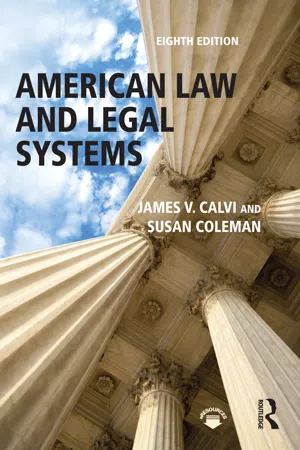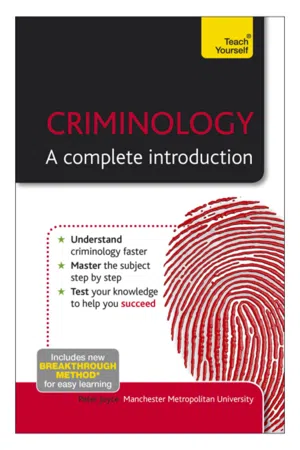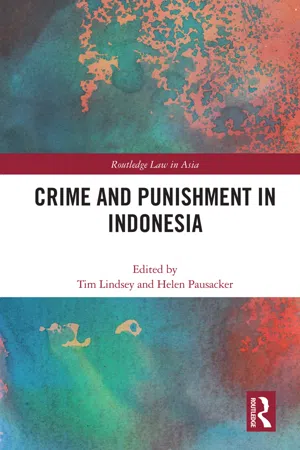Law
US Criminal Procedure
US Criminal Procedure refers to the legal process that governs the investigation and prosecution of criminal offenses in the United States. It encompasses the rules and regulations that law enforcement agencies, prosecutors, and courts must follow when handling criminal cases, including search and seizure, arrest, interrogation, and trial procedures. The procedures are designed to protect the rights of the accused and ensure fair treatment under the law.
Written by Perlego with AI-assistance
Related key terms
4 Key excerpts on "US Criminal Procedure"
- eBook - ePub
- James V. Calvi, Susan Coleman(Authors)
- 2016(Publication Date)
- Routledge(Publisher)
First, the prohibited behavior designated as criminal must be clearly defined so that a reasonable person can be forewarned that engaging in that behavior is illegal. Each criminal statute has certain elements which distinguish that crime, and the State must prove each element. Second, the accused must be shown to have possessed the requisite intent to commit the crime. Third, the State must prove causation. Fourth, the State must prove culpability or criminal liability. Finally, the State must prove beyond a reasonable doubt that the defendant committed the crime with which he or she is charged. Understanding these essential elements of a crime can provide added insight into the substantive and procedural nature of criminal law discussed later in this chapter. PROCEDURAL CRIMINAL LAW In Chapter 4, we discussed criminal procedures primarily from what might be termed a “cookbook” approach; that is, we followed the steps of the criminal process from arrest to appeal, much as one might follow the steps of a recipe. Our purpose in Chapter 4 was to provide the reader with an overview of criminal procedures without getting bogged down in details. In this section, we wish to discuss in greater detail some of the procedural safeguards guaranteed by the Constitution. We will look at three controversial areas of constitutional law: search and seizure, the right to counsel, and the protection against self-incrimination. Our purpose in focusing on these three topics is to provide the reader with an understanding of the history of these procedural safeguards, the philosophical basis of each, and the complexity of the issues involved with each. As noted in the introduction to this chapter, our concern about procedural due process is motivated by our desire to ensure that government “plays by the rules,” by our anxiety about convicting the innocent, and by our fear that government may use the criminal justice system to prosecute unpopular individuals or groups - eBook - ePub
- Liling Yue(Author)
- 2021(Publication Date)
- Hart Publishing(Publisher)
shenpan) as ‘judge, judgement’.28 From the author’s knowledge, the Russian and Vietnamese criminal procedure laws also articulate such principles into their Codes.29 Michael Bayles, ‘Principles for Legal Procedure’ (1986) 5 Law and Philosophy 33.30 Xie Youping and Wan Yi, ‘Reflection and Reconstruction: On the Principles of Criminal Procedure Law’ (2002) 2 Criminal Law Review 472.31 Art 6 of the CPL.32 ibid.33 Art 5 of the CPL.34 Art 9 of the CPL.35 Art 13 of the CPL.36 Art 15 of the CPL.37 Art 37 of the Constitution.38 Art 38 of the Constitution.39 Art 37, the right of a person not to be unlawfully searched, and Art 39, the right against the unlawful search of, or intrusion into, a citizen’s residence.40 Art 40 of the Constitution.41 Art 130 of the Constitution.42 ibid.43 Chen Guangzhong et al, ‘On the Principle of Presumption of Innocence and Its Application in China’ (2013) 10 Journal of Law - Peter Joyce, Wendy Laverick(Authors)
- 2013(Publication Date)
- Teach Yourself(Publisher)
Trial procedure
This chapter considers the way in which those accused of committing a crime are dealt with by the courts. It examines the prosecution process, the safeguards that seek to ensure that those accused of having committed a crime are fairly dealt with by the courts, and the manner in which trials are conducted and a defendant’s innocence or guilt is determined. It also evaluates the strengths and weaknesses of the system of trial by jury which forms an important aspect of trial procedure in countries that include the UK and USA.Prosecuting authorities
Persons who are suspected of having committed a crime and who have been formally charged with a criminal offence will be prosecuted. The mechanism through which this is carried out is a trial before a court of law.The procedures involved in the prosecution of crimes vary from country to country. The starting point concerns the authorities who have the responsibility to decide whether an alleged criminal offence should be prosecuted.Key ideaThe agency that is responsible for initiating and conducting prosecutions varies from one country to another. In England and Wales, prosecutions are the responsibility of the Crown Prosecution Service (CPS).In England and Wales, the initiation of a criminal trial was historically underpinned by common law, whereby it was up to the victim (or a relative) to initiate criminal proceedings. The creation of the office of the Director of Public Prosecution (DPP) in 1879 introduced a system of public prosecution in which trials were the responsibility of the police and conducted in the name of the state. In recognition of the role of the police, in London magistrates’ courts were termed ‘police courts’.The 1985 Prosecution of Offences Act separated the tasks of investigating crime and prosecuting it, and allocated tasks relating to prosecution to a new body, the Crown Prosecution Service (CPS). This agency commenced work in 1986. It is headed by the DPP, and the Attorney General is responsible to Parliament for its operations. It currently employs around 6,000 personnel, of which approximately 3,000 are legal practitioners (usually solicitors). In 2017/18, the CPS prosecuted 533,161 cases and secured 448,327 convictions. In magistrates’ courts, the conviction rate was 84.8 per cent while in the Crown Court 79.9 per cent of CPS cases resulted in conviction.- eBook - ePub
- Tim Lindsey, Helen Pausacker, Tim Lindsey, Helen Pausacker(Authors)
- 2020(Publication Date)
- Routledge(Publisher)
5 This is followed by the trial, at which a panel of (usually three) judges examine the case, decides whether the defendant is guilty or innocent and, if guilty, imposes a punishment. Appeals may then follow. In this chapter, we consider provisions of KUHAP and other laws that regulate each of these five stages, with a particular focus on the rights of suspects and defendants. In doing so, our aim is to provide a brief, descriptive overview of criminal procedure law in Indonesia to assist readers and as background to other chapters in this book.Several themes emerge from the discussion in this chapter. First, the procedural stages just described are generally treated as strict divisions. This is particularly true of primary investigation and prosecution. In practice, this division has undermined cooperation between police and prosecutors, thereby impeding their work and perpetuating the institutional rivalry that has long existed between them (Wagner and Jacobs 2008: 201–2).Second, KUHAP is far from comprehensive. Many other statutes and regulations have been enacted to fill in gaps, or to provide more detail. There are, for example, specific statutes concerning the police (Law No. 2 of 2002), the public prosecution (Law No. 16 of 2004), and every branch of the courts, all of which bear on criminal procedure. Many ‘special’ (khusus ) criminal laws have also been enacted to deal with particular offences – such as terrorism, narcotics offences and money-laundering – and most of these contain their own criminal procedures that prevail over KUHAP to the extent of any inconsistency. A good example of this is Law No. 20 of 2001 amending Law No. 31 of 1999 on the Eradication of Corruption, which Assegaf discusses in Chapter 10 of this book.Various statutes and subordinate regulations cover other issues related to criminal procedure, such as clemency applications, remissions, and parole. Further, the Constitutional Court has issued many important decisions in this area that have had a significant impact on the content of criminal procedure law. This judicial development of the law has occurred even though Indonesia follows the European Civil Law tradition, which relies principally on law made by the legislature and executive and usually accords no formal legal status to judicial decisions as a source of law. Accordingly, while it is true to say that KUHAP is the starting point for Indonesian criminal procedural law, this body of law is now found in a complex and diffuse range of sources.
Learn about this page
Index pages curate the most relevant extracts from our library of academic textbooks. They’ve been created using an in-house natural language model (NLM), each adding context and meaning to key research topics.



